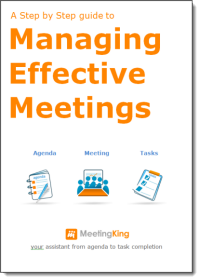
Ad hoc or impromptu meetings, as the name suggests, happen outside your recurring meetings. As a result, they might be disruptive to your regular workflow and create some frustration among your colleagues. For this reason, it is important to learn how to hold spontaneous meetings with efficiency and speed.
We compiled a list of 7 tips that will make your next ad hoc meeting a true success.
1. Determine a Purpose
Before organizing a last-minute ad hoc meeting, you should have a clear goal that keeps you focused. What are you intending to accomplish? When the meeting ends, each participant should be aware of the next steps (if there are any) and how they could assist in solving the problem.
2. Keep It Brief
Ad hoc meetings focus on addressing a specific topic or issue. Consequently, they will normally be short. (Don’t be tempted to add other topics!)
To keep it brief, even if you do not have time to email a proper agenda, write down a few points you need to discuss. Also, try to be concise so that it is easier for participants to understand the situation and what needs to be done.
3. Adapt
Ad hoc meetings are unplanned, so it is important to be flexible as things might not always go the way you had imagined.
For instance, you might not have enough time to prepare an agenda. The meeting room might be taken. Not every person you invite might be available. However, as long as you keep these things in mind, you can adapt and stay focused on the task at hand.
4. Limit the Number of Participants
Any meeting, especially ad hoc, will be more productive with smaller teams. To make sure you invite the right participants, you should consider 3 things:
- The goal you want to achieve
- The individual’s knowledge, skill set, and previous experience
- If the person is directly affected by the information
This way you will not waste other coworkers’ time and have more engaged attendees.
5. Designate Action Items
Participants should know their next steps when your ad hoc meeting is over. To leave out any ambiguity, assign clear action items for attendees and deadlines to complete them.
The simplest way to do so is by using a meeting management software like MeetingKing. In our tool, you can easily assign tasks and email them to each participant. They even receive automatic reminders to make sure things get done.
6. Follow up
Due to the last-minute nature, ad hoc meetings might feel a bit overwhelming. You can change that by proceeding your meeting with a follow-up. A great way to do so is by sending an email summarizing the points discussed and decisions made during the meeting. Direct communication after a meeting can help everyone to stay on the same page and ensure that any valuable information is not forgotten.
7. Use a Meeting Tool
It is easier to stay organized and focused before, during, and after the ad hoc meeting if you have the right tools to aid you.
Assess the digital tools you already have at hand. You’ll need to write meeting minutes, assign and track action items, share any relevant documentation and have an easy way to collaborate. The good news is that MeetingKing can do all of that in one place!
In Summary
Left unchecked, Ad hoc meetings could quickly become disruptive and unproductive. However, if you follow our tips, your ad hoc meetings will be effective, achieve the set goals and tasks will get completed.
___
The photo above by The Jopwell Collection on Unsplash


